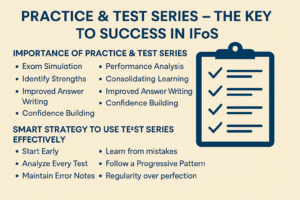How to Analyze Your UPSC Test Series Results Effectively
Preparing for the UPSC Civil Services Examination is not just about studying hard; it is also about studying smart. Test series play a crucial role in this journey. They simulate the real exam environment and help aspirants assess their preparation levels. But simply writing a test is not enough — the real benefit comes from analyzing your UPSC test series results effectively.
In this guide, we’ll break down how you can evaluate your test series results to improve your performance for the UPSC Prelims and Mains.
Why Analyzing Test Series Results Matters
Identifies Strengths and Weaknesses – You’ll know which subjects are strong (like Polity or Geography) and which areas need more revision.
Improves Time Management – You can track whether you are spending too much time on specific sections.
Boosts Accuracy – Analysis highlights careless mistakes and helps reduce negative marking.
Helps in Revision Strategy – Data from test results can guide what topics to revise frequently.
Builds Exam Temperament – Reviewing mistakes ensures you are not repeating them in the actual exam.
Step-by-Step Guide to Analyzing Your UPSC Test Series
1. Break Down Scores Subject-Wise
Create a table of your performance in History, Geography, Polity, Economy, Environment, Current Affairs, etc.
Check the accuracy percentage in each subject.
Example: If you attempted 20 Polity questions, got 15 right → Accuracy = 75%.
This helps you identify where you are scoring consistently and where you are lagging.
2. Track Accuracy vs. Attempt Rate
Many aspirants either attempt too many questions (leading to negative marks) or attempt too few (missing scoring opportunities).
Compare accuracy rate vs attempt rate:
If your accuracy is below 60%, focus on concept clarity.
If your accuracy is high but attempts are low, work on speed and confidence.
3. Analyze the Type of Mistakes
Categorize mistakes into three types:
Knowledge Gap – Didn’t know the fact/concept.
Conceptual Error – Misunderstood the principle.
Careless Mistake – Read the question wrong or marked incorrectly.
👉 Knowledge gaps require study.
👉 Conceptual errors require re-reading NCERTs and standard books.
👉 Careless mistakes require practicing mindfulness during tests.
4. Review Notes Alongside Mistakes
For every wrong question, note down:
The correct answer.
The source (NCERT, Laxmikanth, newspaper, etc.).
A short one-line explanation.
By compiling these, you create your personal error notebook for quick revision before Prelims.
5. Study Trend Analysis Over Time
Keep a record of test scores in a spreadsheet.
Observe improvement patterns — are you getting better at Polity but stagnant in Economy?
If after 4–5 tests your scores are not improving in a subject, rework your study plan.
6. Focus on Negative Marking
Calculate how much you are losing due to wrong attempts.
If you lose 15–20 marks frequently, adopt a more cautious strategy.
Learn intelligent guessing techniques (elimination, linking keywords, etc.).
7. Compare with Cut-Off Trends
Relate your test scores with the expected UPSC Prelims cut-off.
If your average score is consistently 10–15 marks above the cut-off in test series, you are on safe ground.
If below, adjust your revision schedule immediately.
8. Practice Real Exam Conditions
Attempt full-length tests in strict 2-hour timed conditions.
No breaks, no distractions.
Post-exam, spend twice the time analyzing as you spent writing.
9. Revise Based on Insights
The final step is to use test analysis insights to:
Reprioritize your study timetable.
Strengthen weaker subjects.
Improve answer writing skills for Mains.
FAQs on Analyzing UPSC Test Series Results
Q1. How much time should I spend analyzing one test?
At least 4–5 hours. If the test is 2 hours, analysis should take double the time.
Q2. Should I focus only on questions I got wrong?
Not only wrong ones — also analyze guessed answers that turned out correct, so you know if it was knowledge-based or luck.
Q3. How many test series should I attempt before Prelims?
Ideally 30–40 sectional and 10–15 full-length tests. Quality is more important than quantity.
Q4. What if my scores are not improving despite taking multiple tests?
Check if you are only attempting tests without analyzing. The key is in rectifying mistakes, not just practicing blindly.
Q5. Should I use online or offline mode for test series?
Both have benefits. Offline builds real exam practice, while online gives quick performance analytics. Choose based on your exam strategy.
✅ By following these strategies, you will not just write tests but truly transform them into a tool for success in UPSC.










